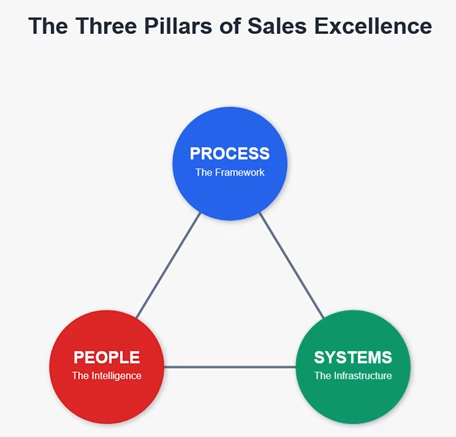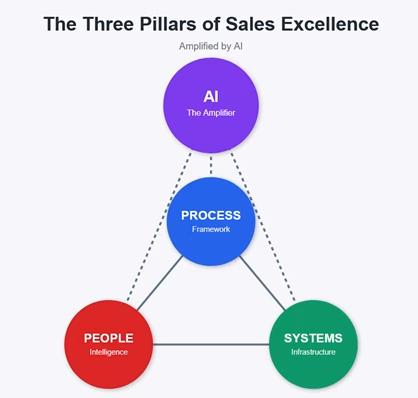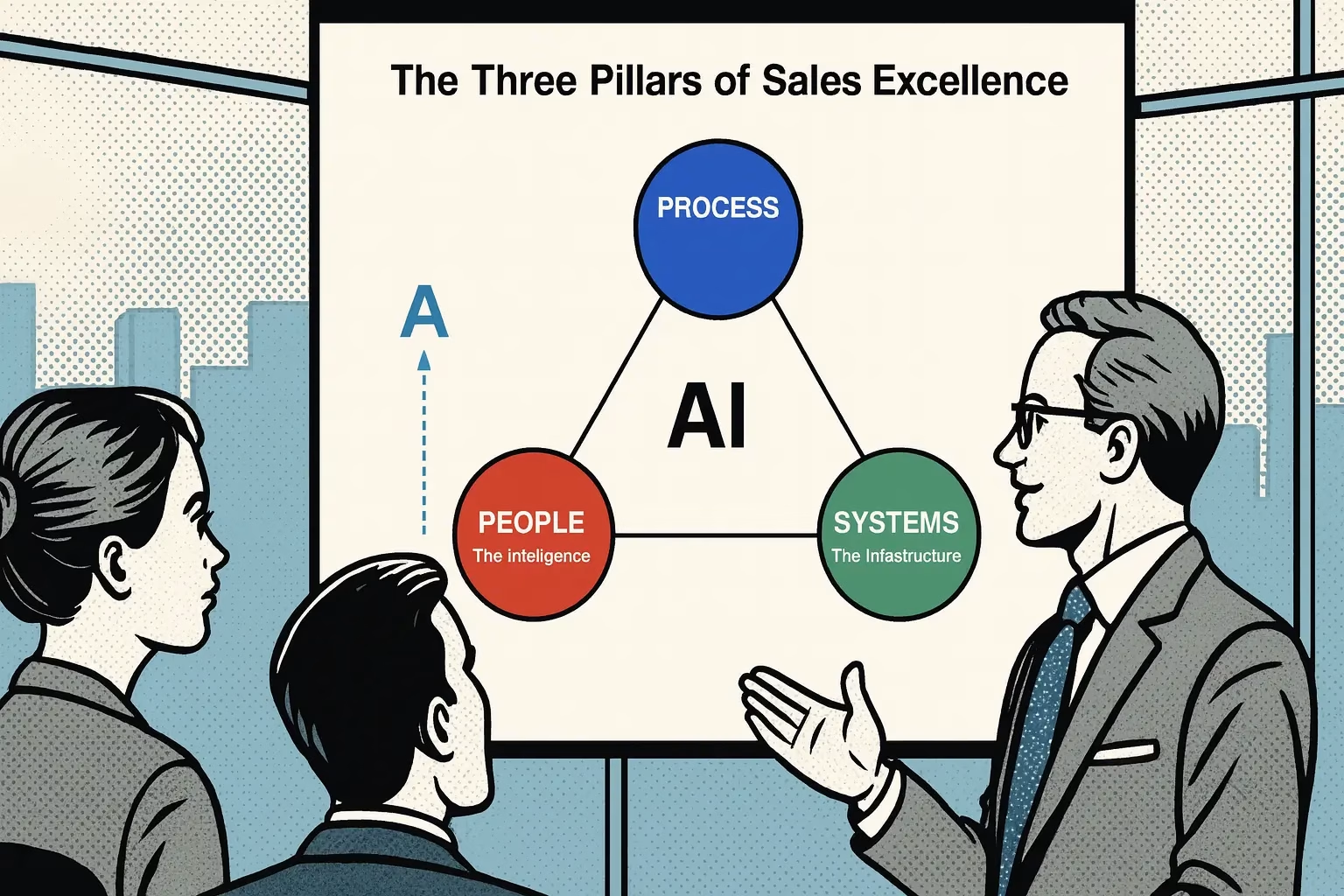B2B sales organizations face an uncomfortable reality. Despite reducing quotas by 19% year-over-year, only 69% of sales representatives achieved their targets in 2024. Had quotas remained flat, 79% would have missed their numbers entirely. This performance crisis reveals a fundamental misunderstanding about what drives sales excellence.
Most organizations focus on a single solution: better people. They replace underperformers, hire expensive talent, or deploy generic training programs. This approach fails because it ignores a critical truth—exceptional sales performance requires three elements working in concert: Process, Systems, and People. Remove any one element, and the entire structure collapses.
Understanding the Performance Triangle
The concentration of sales performance illuminates why all three elements are essential. Just 17% of representatives generate 81% of revenue, while the performance gap between top and average performers has widened to 8.9x from 6x the previous year.
This extreme concentration isn’t about talent alone. Top performers demonstrate 588% higher likelihood of following qualification methodologies and engage economic buyers 489% more frequently before presenting solutions. These aren’t innate abilities—they represent the intersection of disciplined process, supporting systems, and individual execution.
Yet only 15% of teams have at least 50% of representatives reaching 80% of quota. This widespread failure occurs because organizations optimize individual elements while ignoring their interdependence.
The Three Essential Elements
Process: The Framework for Success
Process provides the structured approach that guides sales activities from initial contact through close. Without process, sales becomes entirely dependent on individual intuition and experience, creating unreliable and unscalable results.
Organizations with structured sales processes achieve 25% higher win rates compared to informal approaches. When qualification methodologies reach full utilization, win rates increase by 311%. These improvements demonstrate process impact, but process alone isn’t sufficient.
Process without systems remains theoretical—a documented approach that exists in presentations but not in daily execution. Process without people becomes rigid bureaucracy that ignores market realities and customer needs. Process requires both systems to enable it and people to adapt it.
Systems: The Infrastructure for Execution
Systems provide the infrastructure that enables process execution at scale. CRM platforms, data analytics, automation tools, and communication systems transform process from concept into executable reality.
Modern sales systems deliver measurable impact: properly implemented CRM platforms generate 245% ROI, with companies earning $8.71 for every dollar spent. Organizations with comprehensive sales enablement achieve 84% quota attainment compared to the industry average of 29%.
However, systems without process become expensive technology graveyards—tools purchased but never properly utilized. Systems without people become rigid automation that frustrates customers and limits adaptability. Systems require both process to guide their implementation and people to leverage their capabilities.
People: The Adaptive Intelligence
People provide the adaptive intelligence that makes process and systems effective in complex, changing environments. Sales representatives interpret customer needs, navigate stakeholder politics, and adapt approaches to specific situations in ways that process and systems alone cannot.
The modern B2B environment demands this human element. Buying committees now average 10+ stakeholders, with multinational deals involving 15+ decision-makers. The typical buying cycle stretches 11.5 months, with 86% of purchases stalling at some point. This complexity requires human judgment, relationship building, and creative problem-solving.
Yet people without process operate inefficiently, reinventing approaches for each situation rather than building on proven methods. People without systems lack the infrastructure to execute consistently, spending time on administrative tasks rather than selling. People require both process to guide their efforts and systems to amplify their impact.
How the Triangle Creates Superior Performance
Dynamic 1: Process Guides, Systems Enable, People Execute

Consider deal progression. Currently, 44% of deals slip beyond original close dates, and when deals slip more than 8 weeks, win rates plummet by 67%. This systematic failure reveals the triangle in action.
Process establishes the methodology for preventing slippage—regular stakeholder engagement, milestone tracking, and risk identification protocols.
Systems enable execution by providing automated alerts when deals show slippage indicators, dashboards tracking progression against timelines, and templates for stakeholder communication.
People execute by interpreting the signals, adapting approaches to specific situations, and building relationships that prevent deals from stalling.
Remove any element, and the others fail. Process without systems means representatives manually track everything, consuming time better spent selling. Systems without process generate alerts that representatives don’t understand or trust. Process and systems without skilled people create rigid approaches that frustrate customers and miss opportunities.
Organizations optimizing all three elements reduce deal slippage from 44% to under 20%, directly impacting win rates and revenue.
Dynamic 2: Systems Capture, Process Standardizes, People Improve
The 588% differential in methodology adherence between top and average performers reveals another triangle dynamic: continuous improvement through systematic learning.
Systems capture data about what works—which qualification questions predict close rates, which stakeholder engagement sequences advance deals, which proposal approaches win business.
Process standardizes proven approaches, translating individual success patterns into repeatable methodologies that all representatives can follow.
People improve by learning from systematized knowledge while contributing their own insights and adaptations back into the system.
This creates a virtuous cycle. Top performers naturally excel at certain approaches. Systems capture these patterns through data analytics. Process translates patterns into methodologies. Other representatives adopt these approaches through their own natural styles. Their variations and improvements feed back into the system, continuously refining both process and execution.
Organizations that optimize this cycle see dramatic results: companies with formal sales processes achieve 7% higher revenue attainment, 11% greater quota achievement, and 26% lower customer churn. These improvements compound over time as the learning cycle accelerates.
Dynamic 3: People Adapt, Process Evolves, Systems Scale
Modern B2B sales complexity demands continuous adaptation. Buyers now complete 57% of their purchase journey before engaging suppliers, spending only 17% of their time with sales representatives. By 2025, 80% of B2B sales interactions will occur through digital channels.
People encounter these changes first, experiencing shifting customer expectations and competitive dynamics in real-time interactions.
Process evolves based on what people learn, incorporating new approaches to digital engagement, stakeholder mapping, and value communication.
Systems scale successful adaptations across the organization, ensuring that improvements reach all representatives rather than remaining isolated innovations.
This adaptation dynamic becomes particularly critical in complex sales environments. Representative turnover has increased from 22% to 36% industry-wide. Without systems and process, each departure loses institutional knowledge. With the triangle optimized, knowledge resides in the system and process, enabling new representatives to achieve productivity faster while contributing their own innovations.
The Measurement Triangle: Tracking Performance Across All Three Elements
Effective performance management requires measuring all three elements and their interactions, not just individual results.
Process Metrics
- Methodology adherence rates across the team
- Stage-to-stage conversion consistency
- Average time in each sales stage
- Stakeholder engagement completeness
These metrics reveal whether representatives follow proven approaches and where process gaps exist.
System Metrics
- CRM data quality and completeness
- Tool utilization and adoption rates
- Automation effectiveness
- Response time improvements
These metrics show whether systems enable or hinder execution.
People Metrics
- Individual win rates and deal velocity
- Customer satisfaction and relationship strength
- Skill development and capability growth
- Adaptation to changing conditions
These metrics track individual performance while revealing where additional process or system support is needed.
Triangle Interaction Metrics
The most valuable metrics measure how the three elements work together:
- Process-System Integration: Time saved through automation, data-driven decision quality, predictive accuracy
- System-People Integration: User satisfaction with tools, capability enhancement through technology, innovation adoption rate
- People-Process Integration: Process compliance with effectiveness, adaptation success rate, improvement contribution frequency
Organizations tracking these interaction metrics identify optimization opportunities invisible when measuring elements in isolation.
Why Single-Element Strategies Fail
The performance data reveals why focusing on individual elements produces disappointing results.
The Talent-Only Approach
Organizations hiring expensive talent without optimized process and systems waste their investment. Even exceptional individuals struggle when processes are broken or systems inadequate.
Current data proves this: organizations with structured processes achieve 25% higher win rates regardless of individual talent levels. The systematic failures that cause 44% of deals to slip affect all performers, proving that individual excellence cannot overcome process and system deficiencies.
The enormous costs of the talent-only approach extend beyond financial impact. With turnover at 36% industry-wide, replacing team members destroys institutional knowledge and disrupts customer relationships. Without process and systems to capture and transfer knowledge, each replacement cycle weakens organizational capabilities.
The Process-Only Approach
Organizations implementing process without adequate systems or people development create frustration rather than performance improvement. Sales representatives see process as bureaucratic overhead rather than enablement when systems don’t support execution or when they lack the skills to execute effectively.
The training industry promotes process-focused solutions that fail because they ignore system and people requirements. A SaaS company selling to enterprise clients faces different challenges than a manufacturing firm expanding geographically. Generic process training cannot address these nuances without customized systems and people development.
The Technology-Only Approach
Technology investments without process and people optimization produce minimal results. AI adoption in sales has nearly doubled to 43% of professionals, yet only 21% of organizations have fully enabled AI across sales operations.
The critical insight: technology amplifies existing processes and capabilities, both effective and ineffective. Organizations with structured methodologies see dramatic benefits from AI—50% higher win rates, 35% improvement with AI-guided insights, 2+ hours daily saved through assistance. Those with informal processes show minimal improvement despite technology investment.
CRM platforms demonstrate this dynamic clearly. While 91% of companies use CRM systems, properly implemented platforms delivering 245% ROI require optimized process defining what data matters and trained people who understand how to leverage the system.
Building the Complete Triangle
Organizations achieving superior performance optimize all three elements simultaneously rather than sequentially.
Starting with Assessment
Effective transformation begins with comprehensive analysis across all three elements:
Process Assessment examines current methodologies, identifies gaps between documented and actual approaches, and reveals where process creates value versus friction.
System Assessment evaluates technology effectiveness, identifies underutilized capabilities, and reveals where systems enable versus hinder execution.
People Assessment analyzes individual capabilities, identifies skill gaps, and reveals where representatives need additional support or development.
Most importantly, assessment examines interactions between elements—where process and systems align or conflict, where people struggle with process execution, where systems don’t support process requirements.
Integrated Optimization
Organizations achieving 50%+ year-over-year growth improvements optimize the triangle through integrated approaches:
Process Design starts with clear objectives and reverse-engineers every element to support those goals, but design incorporates system capabilities and people realities rather than theoretical ideals.
System Implementation focuses on enabling process execution and supporting people development rather than technology for its own sake. Organizations prioritize tools that integrate with existing workflows and provide clear value to representatives.
People Development builds capabilities required for process execution and system utilization while respecting individual strengths and natural working styles. Representatives learn through structured practice rather than generic training, with systems providing ongoing coaching and feedback.
This integrated approach creates multiplicative rather than additive effects. A recent manufacturing services engagement demonstrates the power: revenue grew from $25M to $52M in three years (27% CAGR), market penetration increased from 8% to 22%, sales cycle reduced by 35%, win rate improved by 48%, customer acquisition cost reduced by 23%.
These results occurred through simultaneous optimization of process (comprehensive funnel engineering), systems (CRM optimization for analytics and automation), and people (continuous coaching and performance optimization).
The Sustainable Advantage
Organizations optimizing the performance triangle create sustainable competitive advantages that continue delivering results long after initial implementation.
Process Excellence becomes an organizational asset providing ongoing competitive advantage, but only when supported by systems that enable execution and people who continuously improve approaches.
Technological Capabilities amplify effectiveness, but only when integrated with sound process and skilled people who understand how to leverage them.
Talent Development creates individual excellence, but only when supported by process that guides efforts and systems that amplify impact.
The triangle creates resilience against market changes and competitive pressures. When one element requires adaptation—new competitors change required processes, new technologies emerge, or key people depart—the other two elements provide stability and enable rapid adjustment.
The Path Forward
Sales and marketing leaders face a fundamental choice: continue optimizing individual elements hoping for better results, or embrace the performance triangle that delivers predictable, sustainable growth.
The evidence overwhelmingly supports integrated approaches. Organizations with all three elements optimized achieve 7% higher revenue attainment, 11% greater quota achievement, 25% higher win rates, and 26% lower customer churn compared to those focusing on individual elements.
Transformation begins with comprehensive assessment of all three elements and their interactions. Understanding current state across the triangle reveals specific optimization opportunities that deliver measurable results.
The approach requires leaders to abandon single-solution thinking and embrace the complexity of integrated optimization. This demands new skills and perspectives, but creates sustainable competitive advantages that continue delivering value as markets evolve.
Modern sales environments demand sophisticated approaches that optimize process, systems, and people simultaneously. Organizations that master this integration position themselves for sustained competitive advantage in increasingly complex markets.
The question isn’t whether individual elements matter—it’s whether leadership is ready to optimize all three elements and their interactions to unlock the performance potential that already exists within their organizations. The performance triangle isn’t optional—it’s the fundamental architecture of sales excellence.
AI: The Fourth Pillar or System Accelerator?
As AI adoption in sales accelerates—doubling from 24% to 43% in just one year—a critical question emerges: Does AI represent a fourth essential pillar, or is it simply an advanced component within the Systems element?

The answer reveals itself in the performance data. Organizations with structured processes achieve 50% higher win rates through AI-optimized activities and 35% improvement with AI-guided insights. Sales teams using AI show 1.3x higher likelihood of revenue increases, with 83% reporting growth compared to 66% without AI. However, the critical pattern is clear: organizations with informal processes show minimal improvement despite AI adoption.
AI is not a fourth pillar—it’s a powerful accelerator within the Systems element that amplifies the effectiveness of all three pillars when they’re properly aligned. Like CRM platforms that deliver 245% ROI when properly implemented, AI multiplies the impact of the existing triangle but cannot compensate for weakness in any element.
AI accelerates Systems by automating routine tasks (saving representatives 2+ hours daily), enhancing CRM capabilities with predictive analytics, and enabling the 60% increase in demos and meetings through AI-enhanced prospecting. Yet these benefits materialize only when integrated into coherent system architectures rather than deployed as isolated tools.
AI supports People by providing personalized insights, reducing administrative burden, and enabling representatives to focus on high-value activities requiring human judgment. However, AI cannot replace the adaptive intelligence, relationship building, and creative problem-solving that people provide in complex stakeholder environments.
The fundamental insight: AI follows the same rule as every other system component—it amplifies what exists. Organizations with optimized Process, Systems, and People triangles see dramatic AI benefits. Those with broken triangles see minimal improvement regardless of AI sophistication.
Rather than adding complexity with a fourth pillar, successful organizations integrate AI as an advanced system capability that makes the existing triangle more powerful. This integration requires all three elements: Process to guide AI implementation, Systems to provide the infrastructure for AI operation, and People to leverage AI insights effectively.
The performance triangle remains the fundamental architecture. AI simply makes it more powerful when properly integrated into the Systems element that enables the entire structure.
Want to know more, contact us through contact form
